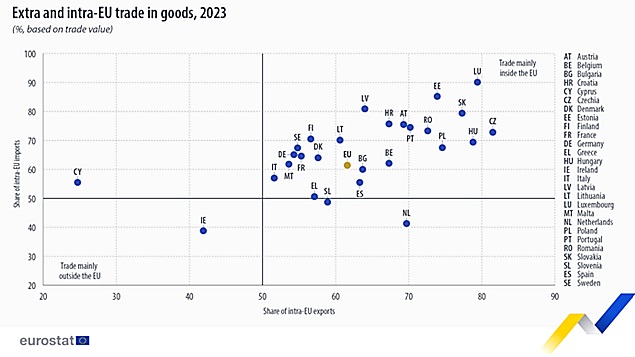1367

The EU recorded a merchandise trade surplus of 38 billion euros in 2023, according to Eurostat's latest analysis of this trade segment.
A stark contrast
This marks a stark contrast from 2022 when the EU reported a deficit of 436 billion euros, primarily due to increased energy imports resulting from high energy prices.
These insights stem from the recently published international trade in goods data by Eurostat. This article presents a handful of findings from the more detailed article in Statistics Explained.
The reason for the shift from a deficit in 2022 to a surplus in 2023 was the sharp decrease in the value of extra-EU imports (-16% compared to 2022).
This decline was mainly driven by decreases in "energy products" (-34% compared to 2022) and "manufactured goods classified chiefly by material" (-21%). For both products, the decline was a combined effect of price decreases and volume decreases.
The EU's internal market remains robust
The data show that the EU's internal market continued to be at the heart of merchandise trade among EU countries, although the proportion of intra-EU and extra-EU flows in total merchandise trade varied considerably among EU countries, reflecting to some extent historical ties and geographic location.
Among EU members, the highest share of intra-EU imports was recorded in Luxembourg (90% of its total imports), while the highest share of intra-EU exports was recorded in the Czech Republic (82% of its total exports).
In this segment of analysis, according to Eurostat data, Romania ranks an honorable seventh in terms of intra-community exports, as can be seen in the graph in the opening image of this news.
On the other hand, the lowest share of intra-EU imports was recorded in Ireland (39% of its total imports), mainly because its main trading partners are the United States and the United Kingdom.
The Netherlands is the country that imports the most from outside the EU and exports mainly within the EU, continuing to play the role of the main entry point into the EU. In contrast, Cyprus is the country that exports mainly outside the EU, while importing mainly from within the EU.
This is mainly due to its geographical location, which facilitates trade with the Middle East. (Photo: Eurostat.)





